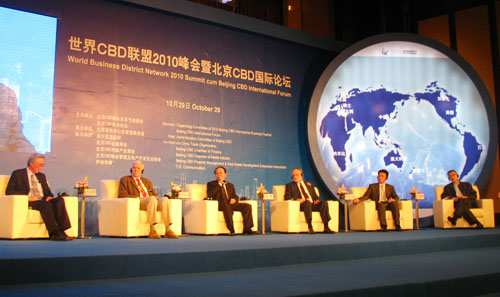Multimodal transportation system to relieve CBD's congested traffic
|
|
|
Beijing CBD Administrative Committee recently announced a new strategy to establish a multimodal transportation system with a total road length of 41.5 kilometer, 39 percent of CBD's total area. [Lishen / China.org.cn] |
Full utilization of underground space and promoting public transportation are the efficient and green ways to relieve the congested traffic of Beijing Central Business District (CBD), said officials and experts at a discussion session of the World Business District Network 2010 Summit on Oct. 29 in Beijing.
The primary area of Beijing's CBD is 3.99 square kilometers. More than 20,000 companies are located in it, and 180,000 employees work there. Fifty percent of regional land-use is for office buildings and hotels, 25percent is for commercial and supplementary facilities, and 25 percent is for apartments. Planning an efficient and convenient transportation system is a key issue for sustainable development.
According to Shi Xiaodong, vice chief planner of Beijing Municipal Institute of Urban planning and & Design, the CBD planned a two-level underground transportation network in 2005. The upper tier is for walkways and commercial areas and the lower for roadways and parking lots.
After five years of construction, walkways and loop roadways that connect landmark buildings and parking lots in CBD, such as Yintai Center, Central Plaza, Jingao (Fortune Plaza), and Hanghua have been finished and begun operation. Projects that link Kerry Center and China World Trade Center, and Kerry and Full Tower have already begun. The planned underground parking has a capacity of more than 60,000.
Beijing CBD Administrative Committee recently announced a new strategy to establish a multimodal transportation system with a total road length of 41.5 kilometer, 39 percent of CBD's total area. Currently, over 80 percent of the planned road construction, which includes highways, urban trunk roads and sub-trunk roads, have been finished. The integration of ground and underground networks has greatly alleviated traffic pressure in CBD.
"To keep sustainable development, we are promoting public transportation and a green way of traffic in the CBD," said Wu Guiying, chief director of the CBD Administrative Committee.
The CBD Administrative Committee has provided free shuttle buses linking subway stations and main office buildings as a supplementary facility to public transportation since 2007. It also sets up bicycle parking lots and has extended the opening hours. These measures appear to be welcomed by commuters.
Experts from Montreal, Canada and Paris, France's La Defense district also introduced their experience on underground space development at the summit.
"Underground space utilization is a high-end mode in urbanization," said Zhu Wenjun, senior engineer of Underground Engineering Institution at Tsinghua University. "Since the CBD announced its eastward expansion plan last year, we have more space to use underground, but we must take environmental protection into consideration. We need to make a long-term plan and reserve some space for future development. "
Delegates from business districts from more than 20 cities and regions all over the world have attended the World Business District Network 2010 Summit and Beijing CBD International Forum.
The World Business District Network was established in 2008.
 0
0 








Go to Forum >>0 Comments